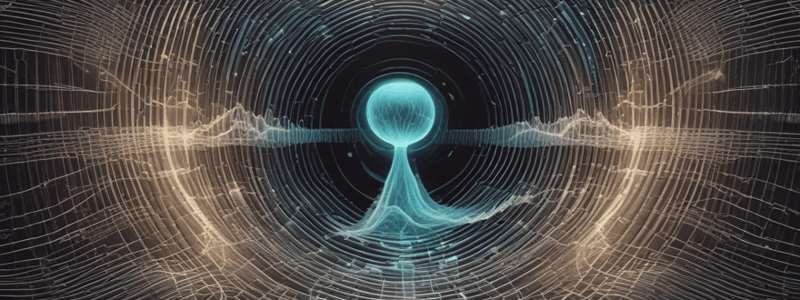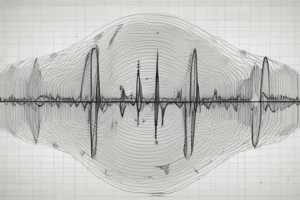Podcast
Questions and Answers
What does Pulse Repetition Frequency (PRF) refer to?
What does Pulse Repetition Frequency (PRF) refer to?
- The percentage of time the ultrasound system transmits sound
- The time it takes for one pulse to occur
- The time between two consecutive sound pulses
- The number of sound pulses generated per second (correct)
What happens to PRF when imaging depth increases?
What happens to PRF when imaging depth increases?
- It becomes irrelevant
- It increases
- It remains constant
- It decreases (correct)
What is the relationship between PRP and PRF?
What is the relationship between PRP and PRF?
- PRP is directly proportional to PRF
- PRP is the square root of PRF
- PRP is the reciprocal of PRF (correct)
- PRP is the square of PRF
What is the unit of Pulse Repetition Period (PRP)?
What is the unit of Pulse Repetition Period (PRP)?
What determines Pulse Duration (PD)?
What determines Pulse Duration (PD)?
What happens to Pulse Duration (PD) if the frequency is increased?
What happens to Pulse Duration (PD) if the frequency is increased?
What is the formula to calculate Pulse Duration (PD)?
What is the formula to calculate Pulse Duration (PD)?
What is the duty factor (DF)?
What is the duty factor (DF)?
What is the typical range of Pulse Repetition Period (PRP) in clinical imaging?
What is the typical range of Pulse Repetition Period (PRP) in clinical imaging?
What happens to intensity when the area of an ultrasound pulse is decreased?
What happens to intensity when the area of an ultrasound pulse is decreased?
What is the term for the weakening of an ultrasound pulse as it travels through a medium?
What is the term for the weakening of an ultrasound pulse as it travels through a medium?
What is the maximum amount of variation that occurs in an acoustic variable?
What is the maximum amount of variation that occurs in an acoustic variable?
What is the definition of a pulse in ultrasound?
What is the definition of a pulse in ultrasound?
What are the two main components of pulsed ultrasound?
What are the two main components of pulsed ultrasound?
What is the purpose of the Dead Time in pulsed ultrasound?
What is the purpose of the Dead Time in pulsed ultrasound?
What is the frequency bandwidth in pulsed ultrasound?
What is the frequency bandwidth in pulsed ultrasound?
What type of ultrasound is predominantly used in echocardiography?
What type of ultrasound is predominantly used in echocardiography?
What is the limitation of continuous wave ultrasound?
What is the limitation of continuous wave ultrasound?
What is the frequency of a cycle that takes 0.2 millionths of a second to occur?
What is the frequency of a cycle that takes 0.2 millionths of a second to occur?
What is the unit of measurement for wavelength?
What is the unit of measurement for wavelength?
Can the wavelength be modified by the sonographer?
Can the wavelength be modified by the sonographer?
What is the formula to calculate wavelength?
What is the formula to calculate wavelength?
What is the effect of shorter-wavelength sound waves on ultrasound images?
What is the effect of shorter-wavelength sound waves on ultrasound images?
What is the propagation speed of sound waves in a medium?
What is the propagation speed of sound waves in a medium?
What determines the speed of sound wave propagation?
What determines the speed of sound wave propagation?
What is the wavelength of a sound wave with a frequency of 5 MHz and a propagation speed of 1.54 mm/μs?
What is the wavelength of a sound wave with a frequency of 5 MHz and a propagation speed of 1.54 mm/μs?
Why is wavelength an important parameter in ultrasound imaging?
Why is wavelength an important parameter in ultrasound imaging?
What is the characteristic of normal incidence in ultrasound?
What is the characteristic of normal incidence in ultrasound?
What factor affects the degree of reflection and refraction in ultrasound?
What factor affects the degree of reflection and refraction in ultrasound?
What is the process of conversion of sound energy into heat within a medium called?
What is the process of conversion of sound energy into heat within a medium called?
What is the result of slower molecular relaxation in a medium?
What is the result of slower molecular relaxation in a medium?
What type of reflection occurs at large and smooth interfaces?
What type of reflection occurs at large and smooth interfaces?
What is the result of higher frequencies in ultrasound?
What is the result of higher frequencies in ultrasound?
What is the characteristic of non-specular reflection?
What is the characteristic of non-specular reflection?
What is the result of the acoustic impedance difference between two media?
What is the result of the acoustic impedance difference between two media?
What is the characteristic of specular reflection in ultrasound imaging?
What is the characteristic of specular reflection in ultrasound imaging?
What is the result of less uniform tissue in diffuse reflection?
What is the result of less uniform tissue in diffuse reflection?
What is the reason for the bright signal in the sonogram of the bone?
What is the reason for the bright signal in the sonogram of the bone?
What is the term for the image artifacts produced by backscatter?
What is the term for the image artifacts produced by backscatter?
What is the condition for refraction to occur?
What is the condition for refraction to occur?
What is the law that defines the refraction of sound waves?
What is the law that defines the refraction of sound waves?
What is the term for the way sound waves spread out in different directions?
What is the term for the way sound waves spread out in different directions?
What is the result of the difference in propagation speeds of sound in different media?
What is the result of the difference in propagation speeds of sound in different media?
What is the factor that determines the direction of the refracted beam?
What is the factor that determines the direction of the refracted beam?
What is the term for the reflection of ultrasound waves back to the transducer?
What is the term for the reflection of ultrasound waves back to the transducer?
Flashcards are hidden until you start studying
Study Notes
Sound Wave Parameters
- A cycle takes 0.2 millionths of a second to occur, which means 5 million cycles occur in 1 second, resulting in a frequency of 5 MHz.
- Wavelength (λ) is the length of a cycle in space and is typically measured in meters, millimeters, or any standard unit of length.
- Wavelength ranges from 0.1 to 0.8 mm in soft tissue and cannot be modified by the sonographer.
- Wavelength is calculated as Speed divided by Frequency: λ (mm) = c (mm/μs) ÷ f (MHz).
- Wavelength is a crucial parameter that influences the diagnostic quality of ultrasound images, with shorter-wavelength sound waves having superior spatial resolution but less penetration.
Propagation Speed
- Propagation speed (c) refers to the rate at which a sound wave moves through a medium.
- Sound waves travel at a consistent speed within a specific medium, regardless of their frequency.
- The speed of sound wave propagation varies across different mediums.
- A decrease in area (focusing) increases intensity because power is more concentrated.
- Attenuation is the weakening of an ultrasound pulse as it travels through a medium.
Pulsed Wave
- A pulse, by definition, must have a distinct beginning and end.
- Pulsed ultrasound comprises two main components: the cycle (the "on" or "transmit" time) and the dead time (the "off" or "receive" time).
- Pulsed transducers are designed to generate multiple, sequential, short pulses, allowing for the simultaneous use of the same crystal or group of crystals for both sound transmission and echo reception.
- Pulsed wave transducers are responsible for generating all types of ultrasound diagnostic images, including both real-time and static.
- The frequency bandwidth of a pulsed transducer emits ultrasound waves that span a variety of frequencies.
Continuous Wave (CW)
- Continuous wave (CW) ultrasound is predominantly employed in echocardiography for acquiring CW Doppler information.
- Continuous wave sound is incapable of creating anatomic images.
Pulse Repetition Frequency (PRF) and Pulse Repetition Period (PRP)
- Pulse Repetition Frequency (PRF) refers to the number of sound pulses generated by the transducer per second.
- There is an inverse relationship between imaging depth and PRF, meaning as imaging depth increases, PRF decreases.
- Pulse Repetition Period (PRP) is the time from the beginning of one pulse to the beginning of the next one and is the reciprocal of PRF: PRP = 1 / PRF.
- The determination of PRP is influenced by the sound source and can be adjusted by the operator.
Pulse Duration (PD)
- Pulse duration (PD) is the time that it takes for one pulse to occur.
- PD is equal to the period (the time for one cycle) times the number of cycles in the pulse (n) and is expressed in microseconds: PD(μs) = n × T(μs).
- Sonographic pulses are typically two or three cycles long, while Doppler pulses are typically 5 to 30 cycles long.
Duty Factor (DF)
- The duty factor is the percentage of time that the ultrasound system transmits sound.
- DF is the fraction of the PRP that the sound is on.
Types of Incidence
- Normal Incidence occurs when the ultrasound path is perpendicular to the boundary.
- Oblique Incidence occurs when the ultrasound beam strikes the interface between two media at an angle other than 90°.
Incident Sound in Ultrasound
- The degree of reflection and refraction is influenced by the acoustic impedance differences of the two media.
Factors Contributing to Attenuation
- Absorption is the conversion of sound energy into heat within a medium.
- Factors affecting absorption include relaxation time and frequency.
- Reflection is the redirection of part of the ultrasound wave back towards the source.
- The degree of reflection is influenced by the acoustic impedance difference between the two media.
- Scattering refers to the way sound waves spread out in different directions when they encounter tissues with irregular surfaces or interfaces similar in size to the wavelength of the sound.
- Refraction is the change in direction of a sound wave as it passes across a boundary between two different media at an oblique angle, not perpendicular to the boundary.
Studying That Suits You
Use AI to generate personalized quizzes and flashcards to suit your learning preferences.



